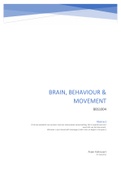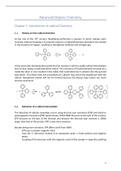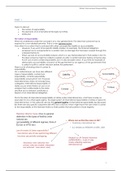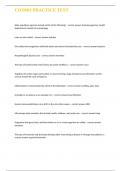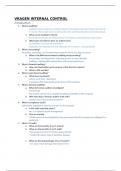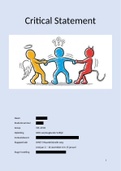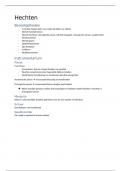O = definities
O = formules
O = example
Tentamen Applied Cognitive Psychology Toolbox:
Lecture 1: INTRO
ACP = adapting the environment to the user instead of in psychology where they adapt the
user to the environment. This is why ACP is more sustainable
❌problems and solutions but ✅trade-off between them
Lecture 2:
Eyetracking = ET
Mouse Tracking = MT
- More conscious - people sometimes chose socially desired behavior (higher fixation
time)
- Lags behind the eye - longer time in AOI (automated optical inspection)
- Takes more time
- Recall is better because people are more conscious so it improved their memory
Aided recall: gehlopen herinnering
- Subjects krijgen opties te zien
Computer experiments: presenting stimuli or recording behavior
- 2 limitations:
1. Resolution: level of detail of a picture (pixel)
2. Throughput: processing speed and bandwidth
- When filming use a temporal frequency that is high enough → so no relevant information
is lost
Sample (/signal) frequency: how many times a signal is measured per second (Hz)
- Nyquist theory: to accurately capture a signal without loss - the sample frequency must
be 2x higher than the highest frequency
Reducing file size:
1. Count colors and determine the bitdepth (# colors in an image)
- The number of bits used to represent each pixel in an image
- 1 bit = 2 possible values: 0 or 1 (black or white)
- 2 bit = 4 possible values: 00,01,10,11
- 3 bit = 8 possible values: 000, 001, 010, 100, 110, 111, 011, 101
- X bit = 2^x possible values
- Grayscale = 8 bits: 256 possible values
- Color = 24 bits: 2^24 possible values
- File size = W x H x Bitdepth
, 2. Produce image on target resolution
3. Use compression techniques
Compression: reducing file size by smartly encoding information
1. Lossy compression: permanently reducing file size
- Quality goes down: used when speed is more important than quality (website/
social media)
- Types of files: JPG, MP3
2. Lossless compression: reversible compression
- Quality remains the same: used when the quality of the data is very important
- Types of files: PNG, FLAC, ZIP
BMP: bitmap
- File format to store digital images
- Simple and uncompressed
TIFF: used to store graphic images
WAV: uncompressed audio (used for research purposes)
Stereo: spatial audio → 3D sound experience
Mono: same sound through all speakers
Lecture 3: Expected value
Expected value (EV):
- The average outcome for an event considering all possible outcomes and their
probabilities
- Weighted average of all possible outcomes
- EV = ∑ p(x) * v
- p(x) - probability of outcome x (# of that outcome/ all possible outcome)
- V - value of the probability
- ∑ - sum of probabilities
- Example: dice roll = (⅙ * 1) + (⅙ * 2) + (⅙ * 3) + (⅙ * 4) + (⅙ * 5) + (⅙ * 6) = 3,5 → so
when throwing many times the average is 3,5
- Example: lottery with ticket = $1
- Winning $100.00 probability 1/1.000.000
- Losing $0 probability 999.999/1.000.000
- EV = (100.000 * 1/1.000.000) + (0*999.999/1.000.000) = 0.10
- So EV of a ticket is $0.10 - since the ticket was $1.00 you would lose 90
cents on the ticket
- Favorable outcome for the organizers of the lottery
Utility: subjective value
- The satisfaction a user gets by making decisions
- Why people make choices when they are given more options
- Accounts for preferences in decision making
Consistency:
- If A > B then A & C > B & C
- If A > B and B > C then A > C

